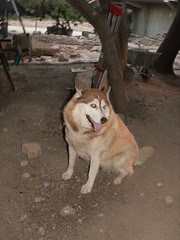This dog hung around the site so we named him Aharoni. Presumably the spirit of the original excavator was keeping an eye on us.
A bit of archaeology jargon: the diggers don’t refer to a year, but to a season. The 2008 season at Ramat Rachel is four weeks long: twenty working days. We are never allowed to forget that every day a precious 5% of the season is disappearing and we have to make the most of it.
Sometimes it doesn’t seem to work out that way.
I worked on Site D1, one of about eight active spots. Lisa, a smart, funny German woman was in charge, assisted by Ephrat, a quieter, younger Israeli, who was raised on Kibbutz Ramat Rachel, five minutes from here). About a dozen volunteers worked on D1 in a big rectangle surrounded by sandbags. Some parts were already several three or four meters deep and have revealed stone walls, an olive (or wine) press, and so on.
On the first Friday Lisa decided to open a new section. That meant using pickaxes to chop open the surface, filling sandbags to mark the edge, and hauling away the rest of the dirt by the bucket and wheelbarrow load until you see something the bosses think is interesting.
The problem is that this area was hardpan, dirt tough as cement. After an hour or so of our slaving away at this Lisa reassigned us. A bulldozer would come on Monday, she assured us, and do the awful work of cutting through the rocklike top layers.
Fair enough. But on Monday no bulldozer appeared. Oded, the Boss Boss Boss, explained cheerfully that all the Arab bulldozer drivers were being examined “to see if they were crazy.” Last week, for the second time this year, an Arab from East Jerusalem had driven his bulldozer into traffic and tried to kill people with it. (This happened the day that Obama arrived in Jerusalem.)
So, since there was no bulldozer, Lisa and Oded decided that Feliz, John, Rachel, Konni and I could be a bulldozer. We worked from 5:30 till 1 that day using pickaxes on soil we had been told a machine could remove much better. (On Friday one of the bosses had joked that they might not bother with a ‘dozer because “fuel is expensive and food is cheap.” It wasn’t so amusing now.)
At the end of the day moral was low, blisters were high, and my lower back hurt (repeat after me, everyone: lift buckets of dirt with your knees, not your back). Lisa called us together and said it would probably be two or three days before the machine was available and did we want to keep going the next day or be reassigned?
Everyone voted for the latter. When it was my turn to speak I said “I want to be productive. If you say a bulldozer can do this better than me then give me something else to do and let the machine do it.”
“Wisely spoken,” said one of the German students.
But we still need to talk about the pottery from that awful Monday. Archaeoloists love pottery because they can use it to determine the date of a site (9th century pottery doesn’t look like 8th century, to an expert), and maybe where it was made. For obvious reasons, pottery found near the surface doesn’t tend to be very useful. It could have been picked up anywhere and trod underfoot anytime in the last few hundred years.
However, we stalwart diggers did find a few nice sherds during that grueling, backbreaking Monday, including a couple of pieces of rim and handle, which are especially useful. When we were cleaning up I gave the specimen bucket to Ephrat who showed it to Lisa. Lisa looked at the top two or three pieces, and shook her head. Ephrat then dumped our day’s finds into the rubbish bin.
To paraphrase the Terry Pratchett novel I am reading, that took the cake, the candle and the biscuit with sprinkles on top. Monday was a very bad day. Oded later admitted that using us as a bulldozer was “our mistake.”
The next day things looked up, as I started sinking into a pit.
Subscribe to:
Post Comments (Atom)



No comments:
Post a Comment